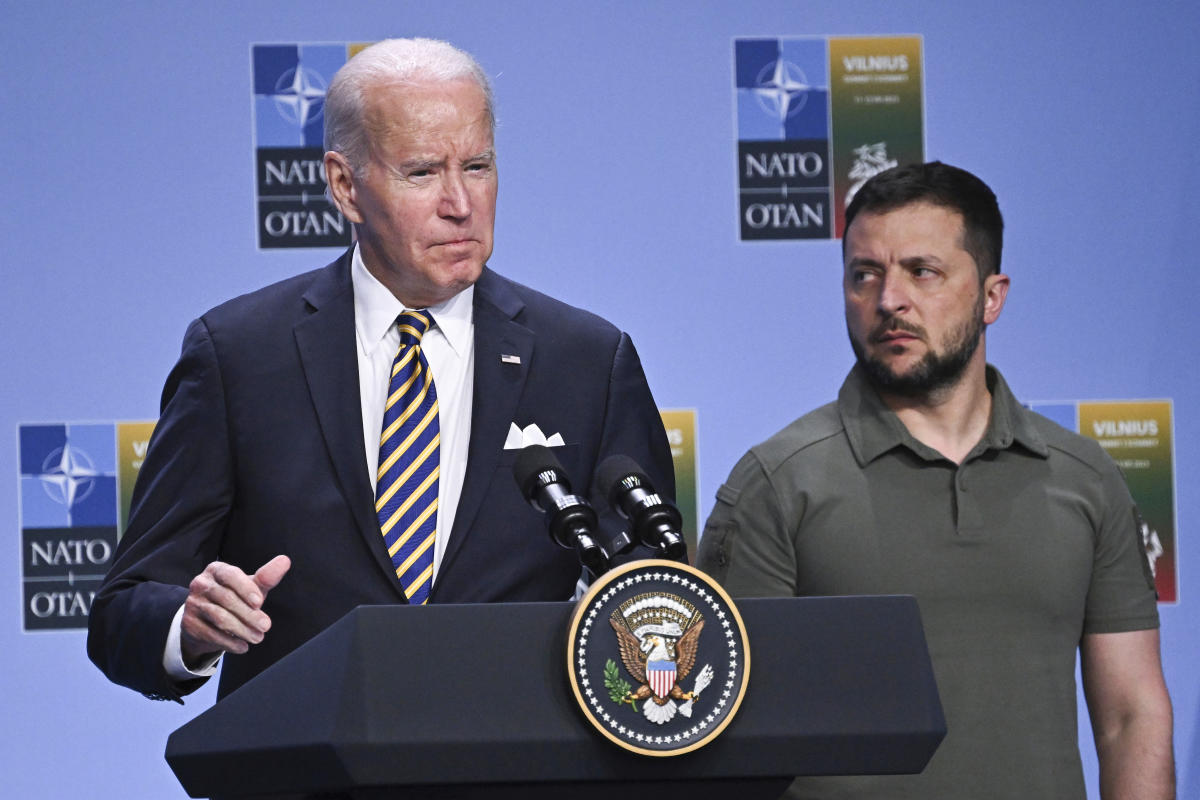BRUSSELS (AP) — NATO leaders plan to pledge next week to continue sending arms and ammunition to Ukraine at current levels for at least another year, hoping to reassure the war-torn country of their continued support and show Russian President Vladimir Putin that they will not give up.
US President Joe Biden and his counterparts are meeting in Washington on Tuesday for a three-day summit to mark the 75th anniversary of the military alliance, as Russian forces extend their lead on Ukraine’s eastern front in the third year of the war.
Speaking to reporters on Friday, NATO’s Secretary General said Jens Stoltenberg said that NATO’s 32 member states have been spending about 40 billion euros ($43 billion) a year on military equipment for Ukraine since the war began in February 2022, and that this should be “a minimum baseline” going forward.
“I expect allies at the summit to decide to maintain this level within the next year,” Stoltenberg said. He said the amount would be distributed among countries based on their economic growth, and that leaders would review the amount when they meet again in 2025.
NATO desperately wants to do more for Ukraine, but struggles to find new ways. NATO allies already provide 99 percent of the military aid they receive. Soon, the alliance will manage the delivery of equipment. But two red lines remain: no NATO membership until the war is over, and no NATO troops on the ground there.
At their latest summit, NATO leaders agreed to speed up Ukraine’s accession process — though the country is unlikely to join for years — and set up a high-level body for emergency consultations. Several countries pledged more military equipment.
A year later, they are looking to deliver a fresh show of unity and resolve, even as election uncertainty roils many of the organization’s strongest members. The potential return of Donald Trump, who undermined trust among allies when he was U.S. president, is a particular concern.
But governments in France and Germany were also weakened in this year’s elections. Italy is led by a prime minister whose party has neo-fascist roots, while an anti-immigrant party leads a shaky coalition in the Netherlands, and Spain’s cabinet relies on small parties to govern. The United Kingdom is getting a new leader.
But whoever is in power, it is clear that NATO cannot do much more.
Recently, Stoltenberg has been pushing for a long-term commitment to Ukraine. Major delays in funding, largely due to political wrangling in the U.S. Congress, have left the country’s armed forces, in his words, “defending themselves with one hand tied behind their back.”
He had hoped the allies would agree to spend at least 40 billion euros a year on weapons in a “large, multi-year” program. But that does not mean that aid is increasing. The amount is roughly the same as what they have spent each year since the war began.
A new plan that leaders are likely to support is a mission to get proper military equipment to Ukraine and streamline training for its armed forces. In their rush to help, Western backers have flooded Ukraine with all sorts of weapons and equipment.
In the early days of the war, anything was welcome, but deliveries have become unmanageable: a multitude of different types of vehicles or defense systems requiring separate maintenance plans and dedicated supply lines to keep them running.
There are also many training programs available outside Ukraine, so diverse that the armed forces are struggling to decide on priorities: which troops to send, to which NATO country and for how long?
“We’ve let a thousand flowers bloom,” a senior U.S. State Department official admitted, but added that with a new mission, likely based in Wiesbaden, Germany, and likely headed by a U.S. general, “NATO can come in and say, We’ve got it.”
The official asked to remain anonymous in order to discuss the plans, which were not yet final.
Sending military equipment via this new mission would also prevent rogue governments or leaders from interfering with joint deliveries. NATO officials say the mission would complement the U.S.-led effort to gather weapons, the so-called Ramstein group.
Another conundrum for leaders is how to formulate Ukraine’s prospects for membership without admitting it. Many allies refuse to admit Ukraine as the fighting continues, fearing being drawn into a broader war with Russia. Hungary is completely opposed to Ukraine’s membership.
In the run-up to the summit, NATO envoys have been considering how to use words like “irreversible” to describe Ukraine’s path to membership, tweaking language that has changed steadily since they promised in 2008 that the country would eventually join.
It is unclear how this will be accepted in Kiev. At their last meeting, the leaders were non-binding on the timing, saying only that they would be “in a position to invite Ukraine to join the alliance when allies agree and conditions are met.”
President Volodymyr Zelenskyy described it as “unprecedented and absurd that no timetable has been set for either Ukraine’s invitation or its membership.” He complained that “vague wording about ‘conditions’ is being added even for inviting Ukraine.”
In recent weeks, Zelenskyy and other Ukrainian officials have been briefed on the developments to prevent a repeat. Stoltenberg said he and Zelenskyy agreed earlier this month that the new steps the leaders will take “will be a bridge to NATO membership and a very strong package for Ukraine at the summit.”
Membership would protect Ukraine from a giant neighbor that annexed the Crimean Peninsula a decade ago and recently seized large swaths of land to the east and south. Before then, Kiev must reform its security institutions, improve governance and curb corruption.
